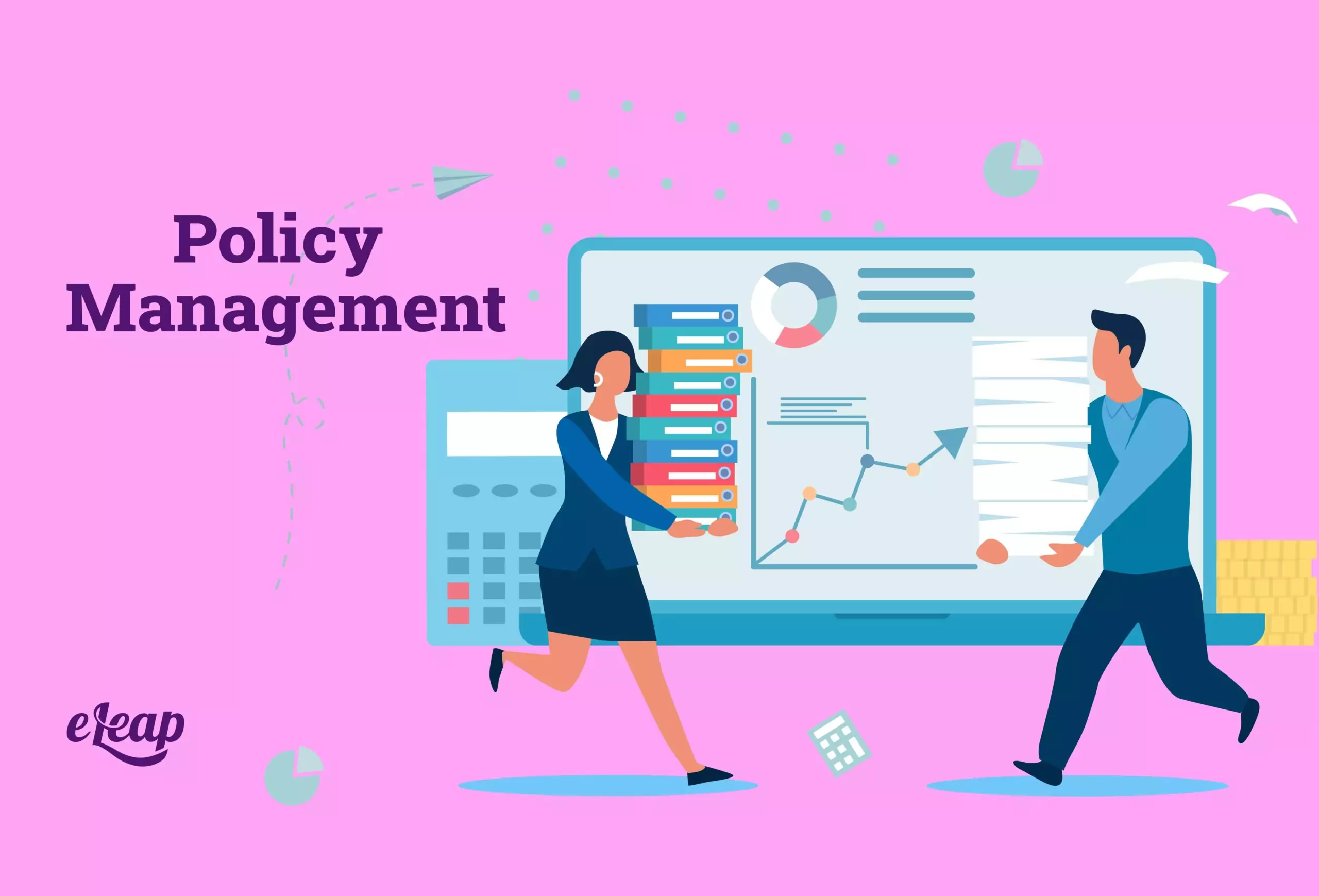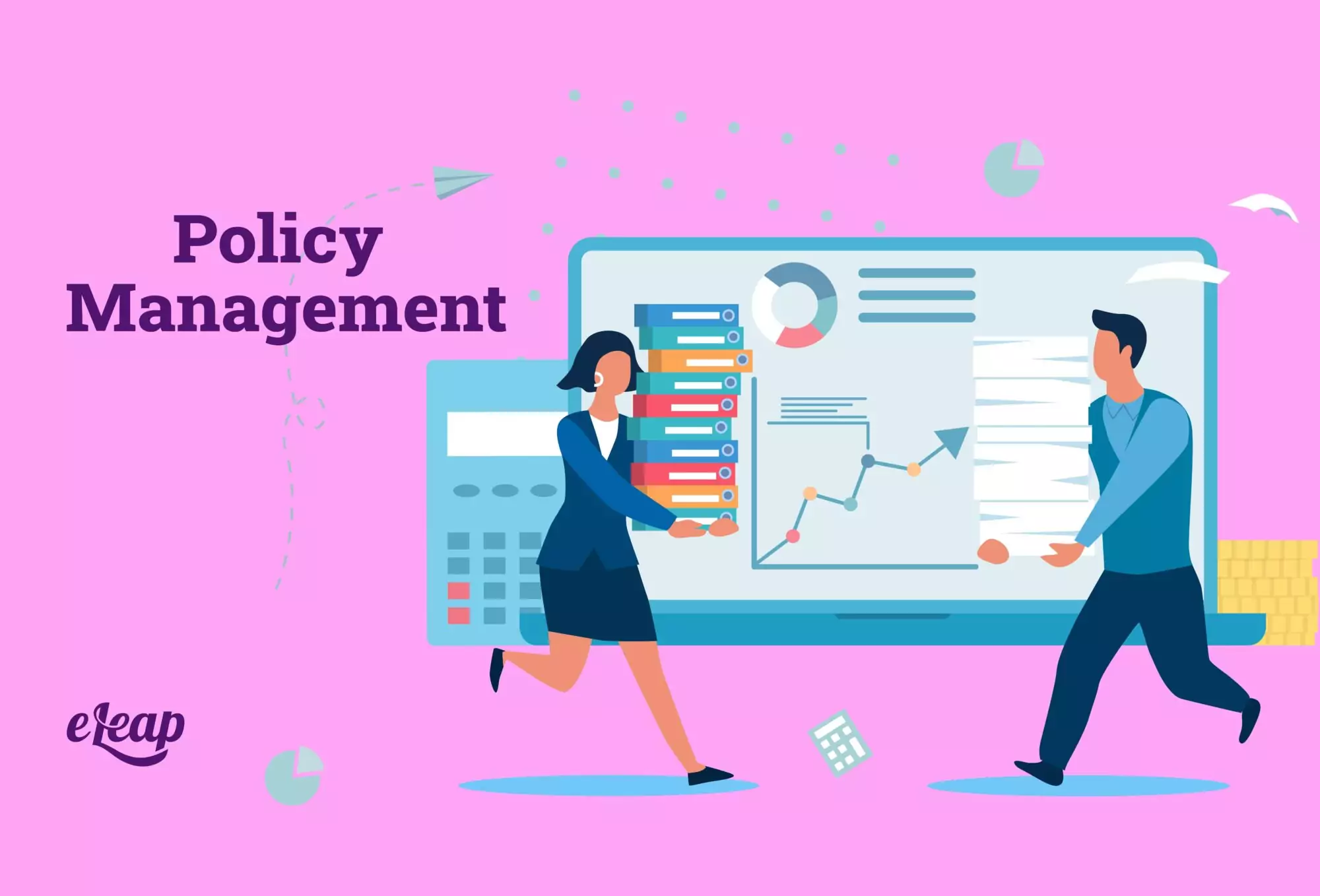Policy Management
Without workplace policies, there's chaos.

Any office or workplace manager knows that the creation of company policies is an essential function of a successful business. Policies state what needs to be done and why, and this is incredibly important for employees as they are being trained for specific tasks and responsibilities.

To use policy management effectively, however, one first needs to know what it is and why it should be used. This article will go into detail defining policy management, detailing the benefits and risks if it is not implemented, and then give steps on how to use it in the workplace to increase production and decrease loss.
Definition of Policy Management
Policy management is comprised of four parts, all of which affect each other in a cycle. All four of these parts work together to cover every policy and procedure that a business has in place. These four parts are creation, communication, management, and policy maintenance.
Remember that policies state what should be done and why, while procedures state how something should be done.
Dangers of Ignoring Policy Management
In the workplace, if policies are not managed effectively, people can make mistakes, revenue can be lost through wasted time, energy, and resources, and people could even get hurt or die if the mistake is tragic enough.
These types of things happen when employees or teams do not know the reasons behind the requirements for a task, or when they do not know where or to whom to turn if they have a question. When a problem occurs, are your employees trained in the action that needs to be taken or will they be left floundering, and your business will be left floundering to boot?
Hurdles to Overcome
We will go over the best way to implement policy management; however, you should be aware of the initial hurdles that you might encounter.
The first is change. People resist change. They want to do things in the way that is most comfortable to them without having to think too much about changing the way they work on a day-to-day basis. However, if you communicate with your team and get their buy-in, this resistance to change will be less intense.
Second, remember that implementing this change is not “one and done.” After policy management is effectively embedded into the workplace, training must be done continually. New employees will need to be onboarded, and this is a great time to remind veteran employees of the reasons for certain procedures. In this way, employees will also be reminded that things cannot slip by the wayside.
All of this takes resources, though. So, know that to implement effective policy management, you will need to be to dedicated your or your management team’s time to enforcing policies.
Benefits of Policy Management
Now, the good news! Policy management will help you attain the following goals: defining the mission and vision of your organization, staying in compliance with regulations, effectively delivering direction, staying competitive in your field, in-depth training for employees, communication of rights and responsibilities, uniformity, risk mitigation, and protection from litigation.
- Mission and Vision – Establishing a mission and vision for a company means that everyone who works for or is a consumer of that company’s product or service is on the same page. They know the bottom line.
- Compliance – Compliance regulation means that everyone knows the rules and why they need to be enforced. This takes away stress from wondering if there is going to be legislation enacted against the company.
- Direction – When directions are clear and concise, employees know how they should behave and what is expected of them. Then they can work more effectively.
- Competitiveness – Every business knows that it is essential to stay ahead of the competition. When policy management is effectively implemented, a company can steer clear of things that will damage them in the eyes of their consumers, which would hurt their competitive edge.
- Training – Employees require in-depth training in order to work productively and efficiently. Having materials and policies in place that can be used quickly and often helps everyone receive the same training.
- Rights and Responsibilities – When everyone is held to the same standards, the employees feel that they are working in a safe environment and that they are respected. This ensures that people will give their best to the company.
- Uniformity – Unless business policies and procedures are uniform, every person and/or team could run however they want, thus creating chaos. Chaos creates negative emotions as well as waste.
- Risk Mitigation – Effective policy management helps eliminate the possibility of people getting hurt or equipment being destroyed due to mistakes or ignorance.
- Protection from Litigation – Having policing such as Terms and Conditions can ensure that disgruntled consumers do not come back to the company in the form of a lawsuit.
How to Use Policy Management Effectively
Now to the good stuff, what you really want to know. Here are the best practices that are shown to be effective in creating effective policy management.
Since policy management at its foundation means planning, organizing, and coordinating the implementation of policies themselves as well as providing leadership surrounding these tasks, you as the manager need to have a good handle on each stage of the process.
Defining Your Needs and Resources
The first step is to define the “six Ms of management” as proposed by Dr. Kaoru Ishikawa. He says that management should consist of: men (all people), methods, machines, materials, Mother Nature, and measurement.
- Men –every human that provides a resource or energy to the organization as a whole
- Methods – how things get done, specific to the business
- Machines – the tangible things that a company needs to produce its product or deliver its service
- Mother Nature – the conditions of the environment or climate that affect production
- Measurement – quantitative and qualitative data regarding the processes or projects that are essential to the business; level of effectiveness
Today’s companies have also added two more ‘Ms’: money and market.
- Money – revenue, capital, profit (and loss)
- Market – a business’s traditional consumer and their needs
Creating a Framework Specific to Your Business
Once all of the above specifications are defined and taken into consideration, a manager can work them all together for something that works for their specific needs.
A policy framework that does its job will have three factions: a hierarchy, a development process, and clear roles and responsibilities.
- Hierarchy – the level of different types of policies and the order in which they affect each other
- Development – how policies and procedures are created as well as the resources used and determining factors of when they should be changed or eliminated
- Roles and Responsibilities – assigning specific tasks to certain people depending on their strengths and experience, in order to ensure that all policies are followed and enforced.
Creation of Policy Implementation Models
Until now, you have been focusing on making sure that you have the time, manpower, accountability, clarity of communication, and buy-in to ensure that everyone is on board with implementing and embedding the policies you will be creating. You have been creating the support structure on which all of this will stand.
Now that all this foundational work has been done, all you have to do is roll out your policies in a simple, easy-to-understand, yet effective model.
Models should start from the beginning (policy creation) and have continual improvement throughout.
Policy Analysis
Once all of these are developed and implemented, you will need to know if they are effective in achieving your company’s goals. Policy analysis should be a continual process, and all positive, as well as negative feedback, should be taken into consideration. This will help you to determine whether the policies you are using can be continued, whether any need to be revised, and/or whether some need to be done away with.
A simple, effective method for analyzing policies could use these six steps:
- Identifying, defining, and understanding the foundational problem
- Determining criteria for evaluation
- Brainstorming possible alternatives
- Assessing pros and cons of the possible alternatives
- Organizing and/or prioritizing alternative solutions into categories
- Implementing, overseeing, and analyzing the results of new policies
Each of these steps should be detailed, precise, and concrete. Get a solid feel for the data from each step before moving on to the next.
This might seem like a great deal of work when you have just done the work of creating a policy management framework; however, it will save you even more time and energy in the long run. You and your team will stop making dangerous mistakes, creating waste, or having a constant turnover of employees due to an unhappy or hostile work environment or a constant loss of revenue, which is stressful for everyone involved.
Policy Regarding Policies (A Meta-Policy)
A meta-policy is a policy about how to create and manage policies. Consider this your overarching idea and way to go about every aspect of your business. A meta-policy will help you determine how and when to make new policies, who should be in charge of this, and the process for drafting and approving new policies.
This holds everyone accountable with a system of checks and balances so that not just one person can make changes to the company.